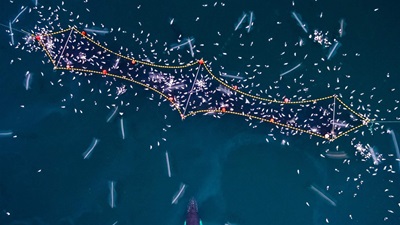In Northeast Atlantic, Management of Small Fish Should Account for Broader Ecosystem
Overfishing has left herring, shad, sardines and other pillars of the marine food web vulnerable

Forage fish – the small species that are the building blocks of ocean ecosystems – are in high demand. Continuing a timeless cycle, larger fish, seabirds, whales and other wildlife are constantly clamoring for their fill of forage fish, from herring and blue whiting in northern European waters to anchoveta and jack mackerel in the Pacific Ocean and sardinellas and bonga shad off the coast of West Africa.
But in recent decades, commercial demand for forage species has grown, driven largely by the expansion of aquaculture – particularly salmon farming – which relies heavily on fishmeal and fish oil derived from these small, nutrient-rich fish. According to the United Nations Food and Agriculture Organization, aquaculture has “surpassed capture fisheries as the main producer of aquatic animals,” intensifying the pressure on wild stocks to meet feed requirements.
In some cases, the consequences of this heavy fishing pressure have been dire, with overfishing and unsustainable management depleting these fisheries and harming the broader ecosystem. Fisheries in the northeast Atlantic are a stark example, where forage species such as herring and mackerel suffer from the impact of ineffective management and overexploitation.
Fortunately, next month, northern European governments have several chances to agree to new rules to protect key forage species. Adopting updated fishing plans should begin a shift towards scientific, ecosystem-based fisheries management (EBFM), which incorporates a holistic view of marine ecosystem health into catch limits and other fisheries decisions.
Evolution in fisheries management could begin in northern European waters
In November, Norway, the United Kingdom and the member States of the European Union, through their formal trilateral negotiations, can adopt a long-term management plan (also known as a harvest strategy or management procedure) to protect North Sea herring and set the stage for much-needed changes throughout the region.
A new North Sea herring harvest strategy – initiated by these three governments and stress-tested by their scientific advisers – would greatly improve upon a now-expired management plan by not only setting benchmarks for future changes in allowable catch and other rules but also considering the stock’s role in marine ecosystem health. Critically, this plan would help ensure that the fishery could meet long-term human demand and the needs of predators, including sandwich terns and black-backed gulls.
Countries should resolve disputes and develop EBFM for other forage fisheries
Separate from those trilateral talks, the North-East Atlantic Fisheries Commission (NEAFC) – which deals with fish stocks in the high seas portion of the region and will meet in London from 11-14 November – can also make strides. NEAFC’s seven members – the Faroe Islands, Greenland, Iceland, Norway, the Russian Federation, the United Kingdom and the EU – should draft and adopt new ecological objectives that would increase protection of additional key forage species, including blue whiting, mackerel and Atlanto-Scandian herring.
Agreeing to new ecological objectives for these fisheries would also help NEAFC members uphold commitments they’ve made to biodiversity conservation – for example as parties to the Convention on Biological Diversity, which in 2022 adopted a target to protect 30% of the world’s ocean by 2030 as well as targets to adopt a more biodiversity-friendly approach to fishing. NEAFC should begin this work quickly, which will allow members to then look ahead to 2026, when they’ve already committed to update their management plans for these forage fish. Those updates should include ecosystem protection.
Regional management for these stocks is complicated. Rules set by NEAFC apply only in the high seas, and the same governments use yet another set of negotiations – the Coastal States consultations that happen throughout October – to regulate fishing for these species within their own territorial waters. Through the Coastal States consultations, these governments have, for several decades, fished these stocks well beyond levels recommended by scientists, both in their own waters and on the high seas. This is largely because of disagreement over their respective shares of catch.
When these governments meet this autumn, both in the Coastal States consultations and as part of NEAFC, they must align their decision-making. They should agree to ecological objectives in NEAFC and use the model of North Sea herring to develop management plans for mackerel and Atlanto-Scandian herring, strengthening management even while they’re resolving catch share disputes.
Positive action in the northeast Atlantic could catalyze global reform
These northeast Atlantic fisheries play a significant role in the global supply of forage fish, but EBFM and long-term management plans are also needed for other large-scale, aquaculture-supporting fisheries around the world. The decisions made this autumn could set the tone for management in other regions in years ahead. Other major fisheries – such as anchoveta in Peru and sardinellas in West Africa – that supply feed for billions of farmed fish and other farm animals also affect important wildlife, such as threatened sharks and marine mammals that depend on these small fish as prey.
Northeast Atlantic governments have an opportunity to catalyze major global change. As seafood demand rises and aquaculture grows, achieving a balance between ecological and industrial needs is urgent. By adopting and implementing an ecosystem-based management plan for North Sea herring and then moving forward with similar strategies and towards ecological objectives for three other key species, these seven governments can show that managing large-scale forage fisheries can be done in a way that meets demand and helps reverse the decline of marine biodiversity.
Jean-Christophe Vandevelde is a manager and Daniel Steadman is an officer working on Pew’s international fisheries project.








